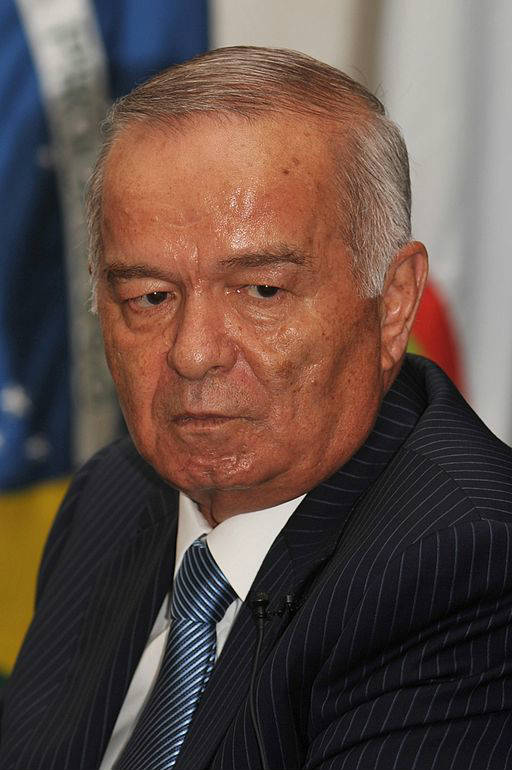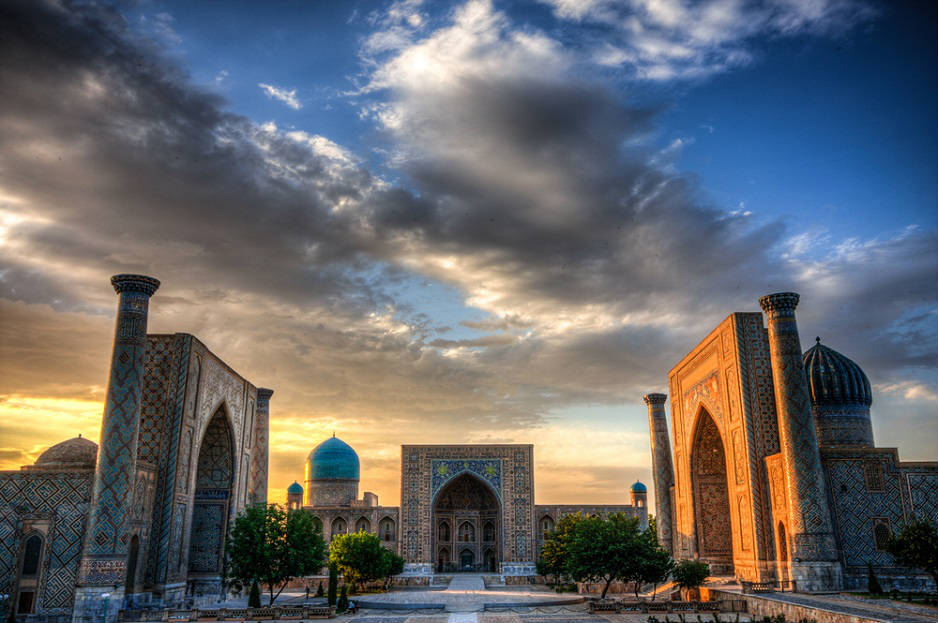Growing unrest in Uzbekistan may quickly spiral out of control.
Something’s cooking in Uzbekistan, and it’s not just plov. The country’s political stability is on the line as a power struggle is underway for control in a post-Karimov reality that is soon approaching. President Islam Karimov himself has been increasingly sidelined as of late, even being pressured to place his own daughter, once thought to be his handpicked successor, under house arrest. The rival security agencies, specifically the National Security Service, are now the ones leading the initiative, and the Karimov family will likely be a political irrelevancy after the president’s passing. Aside from the successionist intrigue, whispers of Karakalpakstan independence (likely Western-influenced) and the reemergence of the Islamic Movement of Uzbekistan (IMU) bode negatively for the country’s internal stability. Thus, the bubbling pot of destabilization is set to overflow any time now, and the intended disastrous consequences are expected to reach as far away as Moscow and Beijing.
Uzbekistan is geostrategic for a few reasons, not least of all is the fact that it abuts all four other Central Asian republics and Afghanistan. Additionally, Uzbekistan has the largest population and military of all the former Soviet republics in Central Asia. This means that not only do events there have the strong possibility of affecting all of its neighbors, but also that regional events can play a large role in its own domestic affairs. Looking even deeper into this, one sees that most of the fertile and densely populated Fergana Valley, the heart of Central Asia, is located within Uzbek territory, further underlining the central placement of Uzbekistan in regional developments.
In a non-regional context, Uzbekistan retains major importance for Russia, China, and the West. In Moscow, Tashkent is seen as a regional holdout to its Eurasian Union integrationist plans, as well as a defector from the Collective Security Treaty Organization (CSTO). Uzbekistan is also in a heated rivalry with CSTO-member Tajikistan, in which Russia could possibly get involved if the conflict goes hot. On the other hand, China has only positive relations with Uzbekistan, since the critical China-Central Asia Natural Gas Pipeline traverses the entire territory of this Shanghai Cooperation Organization (SCO) member. As for the West, although the United States had its military kicked out of the country in 2005 after criticizing the Andijan massacre and the European Union (EU) imposed sanctions around that time, bilateral relations appear to be on the mend. NATO and the US have considered selling Uzbekistan their used Afghan equipment, and the EU reversed its previous arms embargo.
Thus, what one is left with is that Uzbekistan is antagonistic to Russia and its integrationist vision, friendly with China in terms of energy and political dealings, and potentially becoming a bastion of Western influence (or strategic destabilization) after the NATO drawdown. Unquestionably, Uzbekistan is the core of all three actors’ Central Asian policies and exceedingly more relevant to each of them as time goes by.
Power Pivoting in Tashkent
Going back to Uzbekistan’s oncoming destabilization, the country is presently experiencing the climax of a long-running power struggle between the National Security Service and the Interior Ministry before the upcoming presidential election. Seeing as how Gulnara Karimova has been removed from political life (possibly by Rustam Inoyatov from the National Security Service), now may be the time for Inoyatov to make his power play.
At the same time, Stratfor, a political consultancy firm, argues that whoever succeeds Karimov must be a potent enough leader to manage relations between Uzbekistan’s disparate and conniving clans. The firm states that the Tashkent Clan, of which Inoyatov is a member, is on the upswing, having just demonstrated their clout in the Samarkand-heavy Interior Ministry through a recent reshuffling. However, the National Security Service underwent a purge of its own in July 2014, raising questions over how much power they truly hold. Furthermore, a Carnegie Center report from the same month predicts that Karimov will have the final say over whoever replaces him, making the leadership transition even more confusing for observers.
What is clearly happening is that multisided power plays are under way in Tashkent, with various factions and clans vying for power. It is unclear who Karimov would prefer to succeed him, but the fact that his daughter was implicated in a corruption scandal and is currently under house arrest points to the fact that he doesn’t wield as much power as once thought. Either that, or he is under the influence of Inoyatov, which in both cases goes to show that Karimov’s power is rapidly fading even while he remains president. The clan factor, too, cannot be discounted, and “dark horses” may emerge to steal the spotlight or team up against Inoyatov in the future. All in all, Uzbekistan’s secessionist question is messy and convoluted, and there is no certainty over who will replace Karimov if he dies, steps down, refuses to run in the upcoming election or is overthrown, or even which of these scenarios will transpire in the near future. Under such uncertain circumstances, even the specter of color revolution may once again rear its head.
Karakalpak Rumblings
There has been muted talk lately of the beginnings of a Karakalpak secessionist movement in Uzbekistan’s western autonomous republic. Hushed Twitter talk and mysterious fliers have started promoting this idea in the distant and sparsely populated western chunk of the country, although it has been in the works for a few years already. It must be noted that sizeable natural gas reserves are located here (especially under the former Aral Sea bed); although the nearby Bukhara and Xorazm Provinces contain 70% of all resources. However, Karakapakstan is situated on Gazprom’s Central Asia-Center gas pipeline, meaning that it occupies strategic real estate in influencing Russia’s downstream shipments.
Whether or not the population’s grievances are legitimate, what is important to consider is how this cause can be co-opted, if not completely created, by Western intelligence organizations to destabilize the region and maintain a source of pressure on the central government. An upsetting of the provincial dynamic into low or large-scale rebellion and (to the degree that it is possible) insurgency could immediately spill over into Kazakhstan’s energy-rich western provinces or into Turkmenistan, both of which are under-populated and have borders that Uzbekistan may have difficulty monitoring and controlling. If outside-sponsored destabilization cannot be successful in the populated Fergana Valley of the east, it may have a chance of succeeding in the polar opposite environment, the underpopulated Karakalpak deserts of the west.
The IMU Returns
The Islamic Movement of Uzbekistan (IMU) is a terrorist organization that has been actively fighting for an extreme Islamist state in Central Asia since the 1990s. The group was almost completely wiped out by the US in the beginning of the Afghanistan War, only to flee into Pakistan and reconstitute itself with foreign fighters. In this manner, it is a precursor to the Islamic State (IS), in that it is fighting for a radical Islamist state in its home region by means of foreign jihadists. IMU resurfaced in July of 2014 when it carried out the deadly Karachi airport terrorist attack and demonstrated its grandiose terror plans and their effectiveness in action. It has declared its allegiance to IS, thus raising the prospect that it may return to Central Asia after the NATO drawdown.
Seeing as how the IMU now gains its inspiration from its newfound partners in the Middle East, it may even choose to emulate their hybrid fighting style, implementing both conventional and unconventional methods of waging war. Should the group use its alliance with the Pakistani Taliban to team up with its Afghan counterparts, Uzbekistan could see a Central Asian terrorist army sweeping into Turkmenistan (the “sitting duck“of the region) and then flanking the country from its scarcely protected western desert regions. The worst-case scenario would be if this occurs in the midst of a successionist crisis in Tashkent, where the central government would be near-paralyzed in responding to this threat, and the terrorist hordes would overrun large swaths of territory and capture key settlements.
The Shatter Effect
Through the fulfillment of any of these three primary destabilization scenarios, or a combination thereof, the entire Central Asian region would experience a shatter effect that could bring about its total collapse. On the ground level, one of the first repercussions could be massive refugee flows northwards into Kazakhstan. The parts of the Kazakh border nearest to Uzbekistan are poorly guarded, meaning that authorities may not be able to adequately and immediately react to a sudden and unexpected surge there. Since Kazakhstan is in the Eurasian Union, the freedom of movement within this zone could allow refugees (or terrorists posing as such) to enter Russia, thus expanding the problem even further. The breakdown in governance could then lead to Uzbekistan becoming a rapidly failing state, and hence, a perfect incubator for hyper-terrorism on par with portions of the present Middle East. The terrorists could then target the vulnerable Chinese and Russian pipelines crisscrossing Uzbekistan, inflicting considerable economic (and consequently, social) damage on parts of those countries.
Aside from attracting terrorist-prone elements, such as misguided Chechens and revolutionary Uighurs, this terrorist cauldron could spew its contents outward toward its neighbors or further afield to Russia and China. Should they cross into Kazakhstan, Kyrgyzstan or Tajikistan, this would activate the CSTO’s mutual defense obligations and necessitate a Russian military response. Even prior to that, the SCO may attempt a type of intervention into Uzbekistan to prevent it from descending into complete disarray. No matter which way one looks, the chaotic potential energy circling around Uzbekistan could unleash itself in the near future and drag the entire area down with it.
Uzbekistan is on the threshold of major changes, both inside and outside the country. The successionist struggle is being fought largely behind the scenes for now, but ever more often, elements of this battle in Central Asia’s core state are coming to the surface. It is not known exactly which way the wind will blow in Tashkent, but what is certain is that the process is wrapped in mystery and fraught with risk on all sides. While power plays are being made in the capital, mild secessionism is being stoked by unknown forces in the distant energy-rich and geostrategic province of Karakalpakstan. Making matters worse, the IMU is back and its Taliban associates are more invigorated than ever, sparking fears of an Islamic State-like blitzkrieg into Central Asia. Although the situation facing Uzbekistan, its neighbors and even Russia and China is horrendous, US grand strategic planners are provided with an opportunity to apply the combined lessons of Syria and Ukraine to yet another vulnerable theater and test the Reverse Brzezinski theorem of American hegemonic prolongation.
The views expressed in this article are the author’s own and do not necessarily reflect Fair Observer’s editorial policy.
Photo Credit: Posztos/ Natalia Davidovich / Shutterstock.com / Agência Brasil / Flickr
Support Fair Observer
We rely on your support for our independence, diversity and quality.
For more than 10 years, Fair Observer has been free, fair and independent. No billionaire owns us, no advertisers control us. We are a reader-supported nonprofit. Unlike many other publications, we keep our content free for readers regardless of where they live or whether they can afford to pay. We have no paywalls and no ads.
In the post-truth era of fake news, echo chambers and filter bubbles, we publish a plurality of perspectives from around the world. Anyone can publish with us, but everyone goes through a rigorous editorial process. So, you get fact-checked, well-reasoned content instead of noise.
We publish 2,500+ voices from 90+ countries. We also conduct education and training programs
on subjects ranging from digital media and journalism to writing and critical thinking. This
doesn’t come cheap. Servers, editors, trainers and web developers cost
money.
Please consider supporting us on a regular basis as a recurring donor or a
sustaining member.
Will you support FO’s journalism?
We rely on your support for our independence, diversity and quality.









Comment